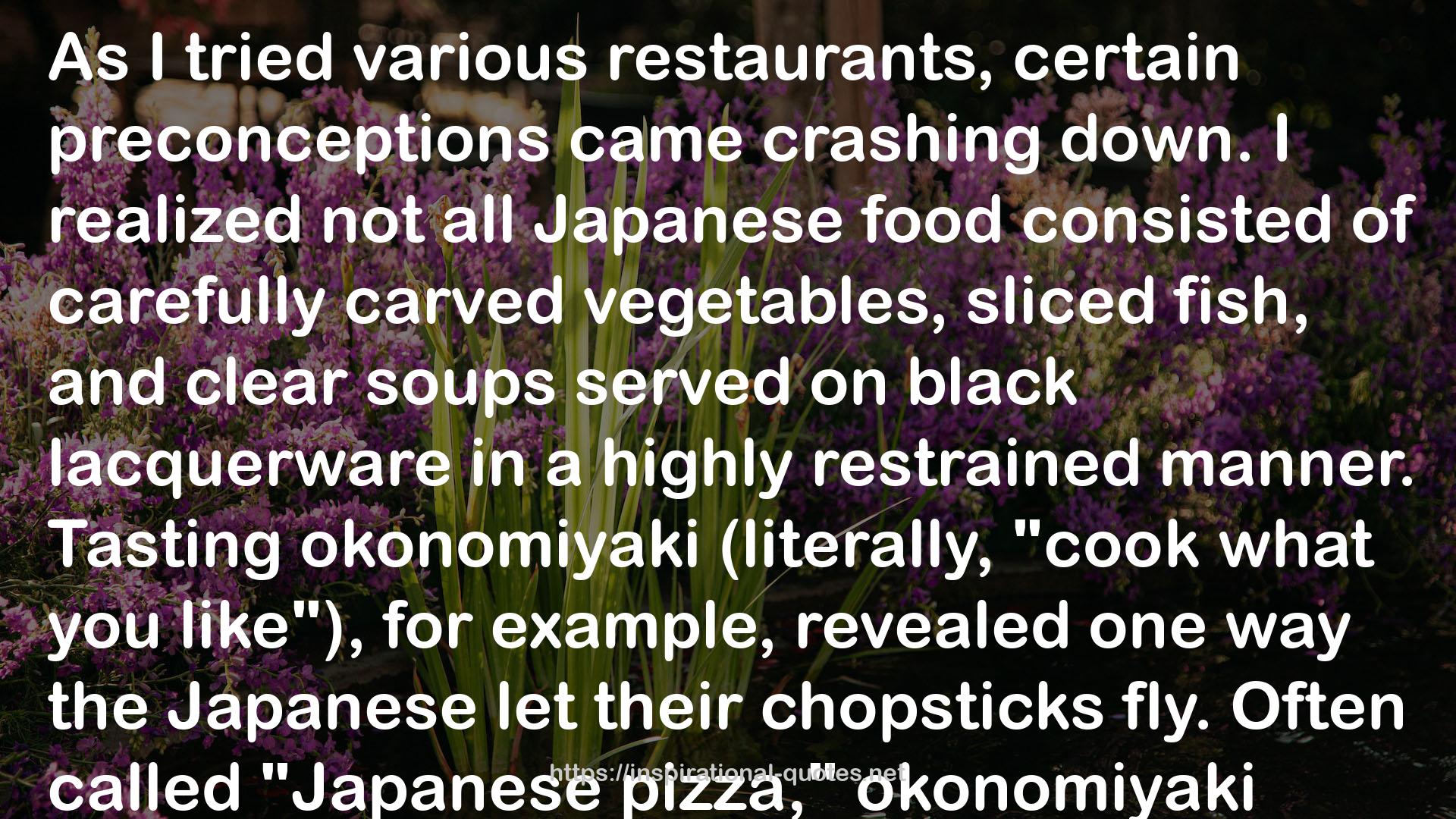" As I tried various restaurants, certain preconceptions came crashing down. I realized not all Japanese food consisted of carefully carved vegetables, sliced fish, and clear soups served on black lacquerware in a highly restrained manner. Tasting okonomiyaki (literally, "cook what you like"), for example, revealed one way the Japanese let their chopsticks fly.
Often called "Japanese pizza," okonomiyaki more resembles a pancake filled with chopped vegetables and your choice of meat, chicken, or seafood. The dish evolved in Osaka after World War II, as a thrifty way to cobble together a meal from table scraps.
A college classmate living in Kyoto took me to my first okonomiyaki restaurant where, in a casual room swirling with conversation and aromatic smoke, we ordered chicken-shrimp okonomiyaki. A waitress oiled the small griddle in the center of our table, then set down a pitcher filled with a mixture of flour, egg, and grated Japanese mountain yam made all lumpy with chopped cabbage, carrots, scallions, bean sprouts, shrimp, and bits of chicken. When a drip of green tea skated across the surface of the hot meal, we poured out a huge gob of batter. It sputtered and heaved. With a metal spatula and chopsticks, we pushed and nagged the massive pancake until it became firm and golden on both sides. Our Japanese neighbors were doing the same. After cutting the doughy disc into wedges, we buried our portions under a mass of mayonnaise, juicy strands of red pickled ginger, green seaweed powder, smoky fish flakes, and a sweet Worcestershire-flavored sauce. The pancake was crispy on the outside, soft and savory inside- the epitome of Japanese comfort food.
Another day, one of Bob's roommates, Theresa, took me to a donburi restaurant, as ubiquitous in Japan as McDonald's are in America. Named after the bowl in which the dish is served, donburi consists of sticky white rice smothered with your choice of meat, vegetables, and other goodies. Theresa recommended the oyako, or "parent and child," donburi, a medley of soft nuggets of chicken and feathery cooked egg heaped over rice, along with chopped scallions and a rich sweet bouillon. Scrumptious, healthy, and prepared in a flash, it redefined the meaning of fast food. "
Image for Quotes
 Often called "Japanese pizza," okonomiyaki more resembles a pancake filled with chopped vegetables and your choice of meat, chicken, or seafood. The dish evolved in Osaka after World War II, as a thrifty way to cobble together a meal from table scraps.
Often called "Japanese pizza," okonomiyaki more resembles a pancake filled with chopped vegetables and your choice of meat, chicken, or seafood. The dish evolved in Osaka after World War II, as a thrifty way to cobble together a meal from table scraps. A college classmate living in Kyoto took me to my first okonomiyaki restaurant where, in a casual room swirling with conversation and aromatic smoke, we ordered chicken-shrimp okonomiyaki. A waitress oiled the small griddle in the center of our table, then set down a pitcher filled with a mixture of flour, egg, and grated Japanese mountain yam made all lumpy with chopped cabbage, carrots, scallions, bean sprouts, shrimp, and bits of chicken. When a drip of green tea skated across the surface of the hot meal, we poured out a huge gob of batter. It sputtered and heaved. With a metal spatula and chopsticks, we pushed and nagged the massive pancake until it became firm and golden on both sides. Our Japanese neighbors were doing the same. After cutting the doughy disc into wedges, we buried our portions under a mass of mayonnaise, juicy strands of red pickled ginger, green seaweed powder, smoky fish flakes, and a sweet Worcestershire-flavored sauce. The pancake was crispy on the outside, soft and savory inside- the epitome of Japanese comfort food.
Another day, one of Bob's roommates, Theresa, took me to a donburi restaurant, as ubiquitous in Japan as McDonald's are in America. Named after the bowl in which the dish is served, donburi consists of sticky white rice smothered with your choice of meat, vegetables, and other goodies. Theresa recommended the oyako, or "parent and child," donburi, a medley of soft nuggets of chicken and feathery cooked egg heaped over rice, along with chopped scallions and a rich sweet bouillon. Scrumptious, healthy, and prepared in a flash, it redefined the meaning of fast food." style="width:100%;margin:20px 0;"/>